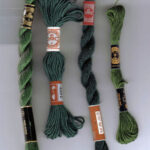Who would have ever guessed that ancient medicine pouches would evolve into expensive and essential fashion statements we know today? But these early handbags would quickly become a sign of status as well as a practical necessity. By the 15th century, embellishments such as embroidery were popular on the traditional gift of a purse that a groom would give to his bride. In some cultures, embellishments could be used to indicate person’s ties to other areas, such as sea shells if you had friends and family by the sea. Depending on the embellishments on a handbag, a person could broadcast that she had many friends or friends from places to be envied.
While wallet type bags carried either in a pocket or from a belt, were popular for a time, the form fitting dresses of the 18th century made those bags impractical. At this time, women began to carry small drawstring bags known as reticules. These handbags carried only the bare necessities for the day or evening out. It was considered ladylike to carry as little as possible, so the bags were tiny.
Later in the 18th century, handbags got larger, and more eclectic. Bags were made in a variety of shape and with variety of fabrics. Women’s magazines included patterns for making bags and women began making purses to match particular outfits. Shoulder bags became popular during World War II and twentieth century technology opened up a variety of new textures and materials from synthetics to hand-woven straws. Casual bags were made in rain proof materials and special tote bags for the beach developed. The variety of fabrics carried over to all hand bag designs and it became common place for women to have many handbags, to meet the needs of the occasion.
By the early 20th century, women were carrying bags every time they left home. While years ago, it was considered ladylike to carry as little as possible, today women regularly carry larger bags needed to accommodate the long work day and travel with children. Today women are gone form home for longer periods of time, frequently working or if not, often with children along. Today, large handbags often serve as briefcases, diaper bags, gym bags as well as a place for women’s personal items.
Handbags now come in an ever increasing variety of styles. The most popular and familiar styles are; bucket, envelope, satchel, hobo, clutch, shoulder, messenger bags, and shopper style. The study of bagology was briefly popular in the 19940’s when a newspaper article of the time attempted to explain handbags and purses, to men. Some psychologists think that the way a woman carries her bag and the type of bag she carries, says something about her.
Today’s handbags have to fit the role of a practical accessory and a fashion statement. With suppliers of handbags grown to include very high end and very low end markets, and copies of designer’s trends common place, everyone can find a handbag to meet their needs and their personality.




